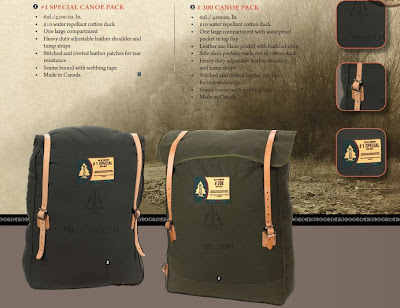In this country, Woods Canada made their own versions beginning in 1909. These packs simply referred to as "Woods Packs" feature prominantly in the paddling films of Bill Mason but had a much more common utilitarian role of hauling forest fire hoses and axes in the bush. Below are the two models, the No.1 Standard and No. 200. These designs were later adapted by Duluth Pack to make their famous Northwoods Pack.


No.1 Standard and No. 200 Woods Packs
The company closed up shop a few years ago, but their their trademark and product line have been acquired by another company and many of these items are being produced again. Here's a pic from their 2009 Catalog.

From the Woods '09 Catalogue
In keeping with the direction of making my own gear, I decided to try and attempt a basic canvas pack for the planned canoe trip next summer. This fastastic Tutorial on making a Canvas Pack was detailed enough, but not having access to an industrial sewing machine limited my options. I also had a hard time sourcing out heavy duty 15oz mildew treated canvas from a local source and wasn't about to pay the expensive shipping and import duties if I ordered from abroad.
Instead, I stumbled on the page of Backcountry Gear Exchange, a small outfitting company based in Kearney (just outside the western access points to Algonquin Park) that was setup to recycle and reuse old gear. I picked up a battered old Woods #200 pack for $25 CND (brand new retail for $115 + tax). It needed repair to the leather components and was missing the tumpline strap, but overall the heavy duty canvas on the faded pack was sound. Here are some pics with it partially filled with a bag of wood shavings.



Views of the pack - front, side, back
The leather straps on the pack needed replacement. Removing the simple splash rivets was simple enough with a pair of pliers, but a former repair job on one buckle area used Slotted and Robertson screws that were preened over square bolts as a makeshift rivets.


Torn tumpline buckle strap; Makeshift rivets
Removing them required sawing the face of the bolt into quarters with a small hacksaw and then chipping away at the metallic fragments. Once loosened, the screws came off easily enough.


Sawing the bolt face; one screw rivet removed
With the other leather pieces removed, the canvas pack will get a thorough washing to get rid of the grimy stains on the exterior. Then the bulk of the leather components will be replaced. More of the next stage posted here.





1 comment:
I bought a woods 200 when i was 16 ish and never used it and just now dug it out ..im gonna be 50 and talk about simplicity and quality x..truly blessed to have had it like new this long ..inside i found a pair of woods 1943 one even has my grand pappys initial
..rip H.E.P
Post a Comment